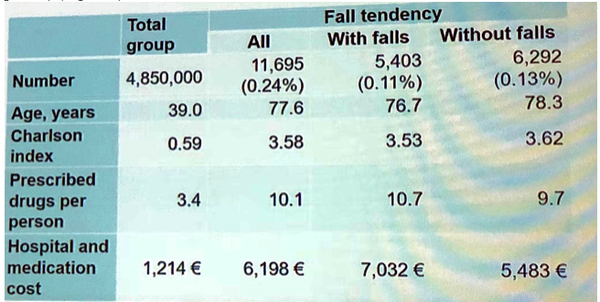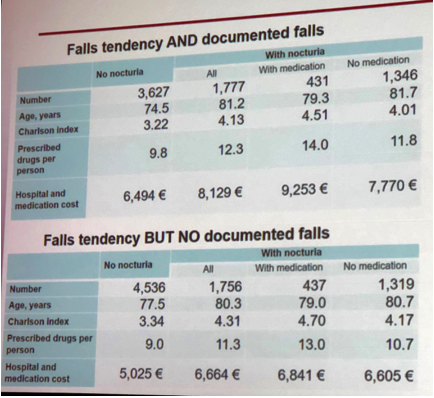Researchers utilized claims from the German statutory health insurances to abstract data on nocturia and tendency for falls in 2014 – 2015. Since there is no specific ICD code for the diagnoses of nocturia, following proxies were used: ICD codes R35, R32, N39.3, N39.4, N32.8, F45.34. Tendency for falls was searched under ICD code R29.6. As a result, 157,076 patients with nocturia and 11,695 patients with a tendency for fall were included into the database.
Study showed that subjects with nocturia have a higher risk for falls and fractures compared to subjects without nocturia. Patients with tendency for falls were in general older and had a greater number of documented concomitant medications (about 10 per person) (Figure 1).

However, patients with tendency for falls and documented history of falls didn’t differ from the subjects with tendency for falls, but no documented falls in terms of age. Higher number of concomitant medications in falls tendency/documented falls group was the only significant difference compared to the group who are likely to fall, but never had a fall documented (Figure 2). In addition, falls were linked to the 28% increase in healthcare costs.

Data suggest that nocturia is associated to the increase in risk for falls and fractures, thus escalating healthcare costs. Feasible reduction in a number of medications in patients with documented falls could be a solution to the issue. Future studies are needed to estimate if micturition-related treatments cause falls or increase a tendency of falls.
Presented by Martin C Michael, MD, Universitätsmedizin Mainz
Coauthors: Schneider T, Gedamke M, Gutho-Hagen S, Vosgerau S
Written by: Hanna Stambakio, BS, Clinical Research Coordinator, Division of Urology, University of Pennsylvania, Twitter: @PennUrology at the 2018 ICS International Continence Society Meeting - August 28 - 31, 2018 – Philadelphia, PA USA


